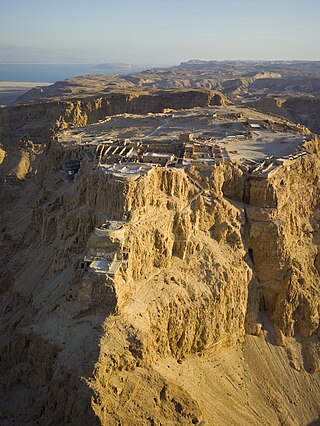
Masada is an ancient fortification in southern Israel, situated on top of an isolated rock plateau, akin to a mesa. It is located on the eastern edge of the Judaean Desert, overlooking the Dead Sea 20 km east of Arad.

Herod I or Herod the Great was a Roman Jewish client king of the Herodian Kingdom of Judea. He is known for his colossal building projects throughout Judea. Among these works are the rebuilding of the Second Temple in Jerusalem and the expansion of its base—the Western Wall being part of it. Vital details of his life are recorded in the works of the 1st century CE Roman–Jewish historian Josephus.

In ancient Rome, thermae and balneae were facilities for bathing. Thermae usually refers to the large imperial bath complexes, while balneae were smaller-scale facilities, public or private, that existed in great numbers throughout Rome.
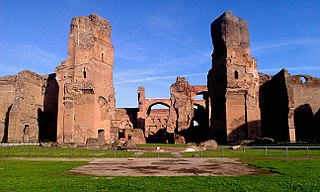
The Baths of Caracalla in Rome, Italy, were the city's second largest Roman public baths, or thermae, after the Baths of Diocletian. The baths were likely built between AD 212 and 216/217, during the reigns of emperors Septimius Severus and Caracalla. They were in operation until the 530s and then fell into disuse and ruin.

Herodion, Herodium (Latin), or Jabal al-Fureidis is an ancient fortress located 12 kilometres (7.5 mi) south of Jerusalem and 5 kilometres (3.1 mi) southeast of Bethlehem. It is located between the villages of Beit Ta'mir, Za'atara and Jannatah. It is identified with the site of Herodium, built by King of Judea Herod the Great between 23 and 15 BCE. Herodium is 758 meters (2,487 ft) above sea level.

The Baths of Titus or Thermae Titi were public baths (Thermae) built in 81 AD at Rome, by Roman emperor Titus. The baths sat at the base of the Esquiline Hill, an area of parkland and luxury estates which had been taken over by Nero for his Golden House or Domus Aurea. Titus' baths were built in haste, possibly by converting an existing or partly built bathing complex belonging to the reviled Domus Aurea. They were not particularly extensive, and the much larger Baths of Trajan were built immediately adjacent to them at the start of the next century.
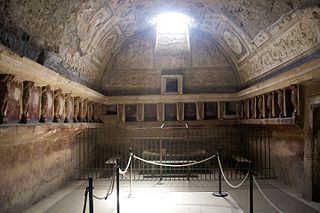
The tepidarium was the warm (tepidus) bathroom of the Roman baths heated by a hypocaust or underfloor heating system. The speciality of a tepidarium is the pleasant feeling of constant radiant heat, which directly affects the human body from the walls and floor.
Virgilio Canio Corbo was an Italian Franciscan Friar and professor of archaeology at the Studium Biblicum Franciscanum in Jerusalem.

Machaerus was a Hasmonean hilltop palace and desert fortress, now in ruins, located in the village of Mukawir in modern-day Jordan, 25 km (16 mi) southeast of the mouth of the Jordan River on the eastern side of the Dead Sea.
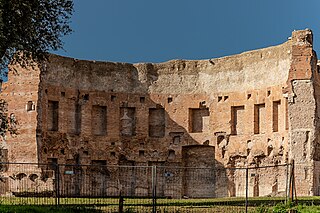
The Baths of Trajan were a massive thermae, a bathing and leisure complex, built in ancient Rome and dedicated under Trajan during the kalendae of July 109, shortly after the Aqua Traiana was dedicated.

A frigidarium is one of the three main bath chambers of a Roman bath or thermae, namely the cold room. It often contains a swimming pool.

Opus sectile is a form of pietra dura popularized in the ancient and medieval Roman world where materials were cut and inlaid into walls and floors to make a picture or pattern. Common materials were marble, mother of pearl, and glass. The materials were cut in thin pieces, polished, then trimmed further according to a chosen pattern. Unlike tessellated mosaic techniques, where the placement of very small uniformly sized pieces forms a picture, opus sectile pieces are much larger and can be shaped to define large parts of the design.

Ehud Netzer was an Israeli architect, archaeologist and educator, known for his extensive excavations at Herodium, where in 2007 he found the tomb of Herod the Great; and the discovery of a structure defined by Netzer as a synagogue, which if true would be the oldest one ever found.

The Welwyn Roman Baths are a Roman ruin preserved under the A1(M) just north of modern-day Welwyn Garden City, Hertfordshire, England. The baths were a small part of the Dicket Mead villa, which was originally built in the 3rd century AD.
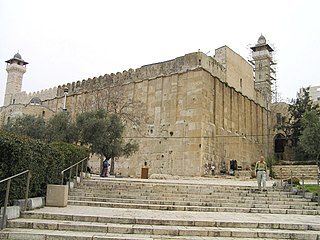
Herodian architecture is a style of classical architecture characteristic of the numerous building projects undertaken during the reign of Herod the Great, the Roman client king of Judea. Herod undertook many colossal building projects, most famously his reconstruction of the Temple in Jerusalem. Many of his structures were built upon comparable, previous Hasmonean buildings and most of his have, in their turn, vanished as well.

Capo di Bove is an archaeological site on the Appian Way on the outskirts of Rome, Italy. It contains the thermal baths of a vast property owned in the 2nd century AD by Herodes Atticus and his wife Annia Regilla.

The Hasmonean and Herodian royal winter palaces, or the Hasmonean and Herodian palaces at Jericho, are a complex of Hasmonean and Herodian buildings from the Second Temple period, which were discovered in the western plain of Jericho valley, at Tulul Abu el-'Alayiq, near the place where the Roman road connecting Jericho with Jerusalem enters Wadi Qelt. Two tells are located on either side of Wadi Qelt.

The preservation and extensive excavations at Ostia Antica have brought to light 26 different bath complexes in the town. These range from large public baths, such as the Forum Baths, to smaller most likely private ones such as the small baths. It is unclear from the evidence if there was a fee charged or if they were free. Baths in Ostia would have served both a hygienic and a social function like in many other parts of the Roman world. Bath construction increased after an aqueduct was built for Ostia in the early Julio-Claudian Period. Many of the baths follow simple row arrangements, with one room following the next, due to the density of buildings in Ostia. Only a few, like the Forum Baths or the Baths of the Swimmers, had the space to include palestra. Archaeologist name the bathhouses from features preserved for example the inscription of Buticoso in building I, XIV, 8 lead to the name Bath of Buticosus or the mosaic of Neptune in building II, IV, 2 lead to the Baths of Neptune. The baths in Ostia follow the standard numbering convention by archaeologists, who divided the town into five regions, numbered I to V, and then identified the individual blocks and buildings as follows: (region) I, (block) I, (building) 1.

The Roman ruins of Tróia is an archaeological site located on the left bank of the River Sado, on the northwest side of the Tróia Peninsula, opposite Setúbal, in the Setúbal District of Portugal. The ruins, which include fish processing facilities, thermal baths, and burial sites are from between the 1st to 6th centuries CE. They have been classified as a Portuguese National Monument since 1910.

Herod's family tomb, with or without upper-case initials, can refer to several sites identified at different times as the burial structures of the immediate relatives of Herod the Great, one of them probably being the famed king's own tomb.




















